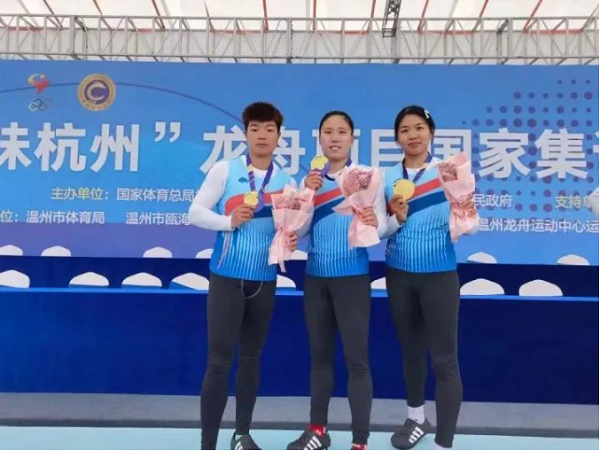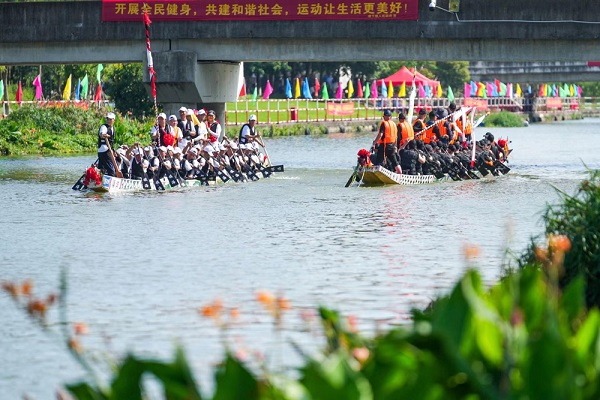How Did Dragon Boat Racing Become the New Darling of Sports
時間:2023-08-10 15:50:52 來源 : DiscoverWenzhou 作者 : ZhongXin
"I'm very happy to represent China in the Asian Dragon Boat Racing event," said Li Shuqi, the captain of the Chinese national dragon boat team. As a native of Wenzhou, she will join 14 other girls to compete for China in the women's 200m, 500m, and 1000m straight sprint events in this year's Asian Games, right in our"backyard" in October.
Transitioning from kayaking to dragon boat racing, she admits that both sports share similarities, but dragon boat racing emphasizes teamwork with multiple individuals"rowing in harmony, united by a common goal." She expressed that the team members will not slack off before the Asian Games and will continue to train rigorously, hoping to bring home gold medals in our"backyard" for our motherland.

A paddle swings through two thousand years. Dragon boat racing is one of the most important folk activities during the Chinese Dragon Boat Festival and has been passed down for over two millennia, particularly popular in the southern regions of China. There are various theories on the origin of dragon boat racing, ranging from ancient sacrificial rituals to commemorate Qu Yuan or Cao E, tracing back to the Warring States period. On May 23, 2011, dragon boat racing was officially listed as a national intangible cultural heritage by the State Council.
The allure of dragon boat racing is evident from its expanding reach. According to the International Dragon Boat Federation, the federation now has 85 member countries worldwide, compared to only 12 when it was established in 1991. Dragon boat racing has gone beyond the limits of the Chinese, East Asian, and Southeast Asian regions, gaining popularity and acceptance among people from various countries and regions, allowing for broader participation.

Why has dragon boat racing remained popular for thousands of years, spreading from China to the rest of the world? Dragon boats serve as a tangible cultural link. According to Cui Lequan, a researcher at the Chinese Sports Museum and the Director of the Sports Culture and Industry Committee of the Chinese Culture Promotion Society, different interpretations of dragon boat racing have emerged over time and in different regions. However, people's understanding of the customs and traditions of dragon boat racing demonstrates astonishing consensus, mainly due to the shared beliefs, aesthetic tastes, and national cultural identification associated with this cultural theme. It embodies the dragon boat spirit of"unity and cooperation, striving for excellence," along with profound patriotism.
Today, dragon boat racing has become a new trend globally. Not long ago, the 13th Dragon Boat Festival was held in the San Francisco Bay Area, where Wenzhou youth working in Silicon Valley spontaneously formed the California Wenzhou Five Horses Dragon Boat Team, showcasing the new charm of Wenzhou's dragon boat racing. Wenzhou Overseas Dragon Boat Bases have been established in Catalonia, Spain, Rome, Italy, and Paris, France, allowing dragon boats to sail from the Mediterranean Sea to the Seine River.
The international stage for dragon boat racing continues to expand. Dragon boat racing became an official event at the 2010 Guangzhou Asian Games. Prior to the finals of the canoeing event at the 2020 Tokyo Olympics, competitive dragon boating made a stunning appearance as a demonstration event on the world stage.
This year's Hangzhou Asian Games will mark the third time dragon boat racing steps onto the Asian Games arena. As the venue for the dragon boat racing events at the Hangzhou Asian Games, the Wenzhou Dragon Boat Sports Center will award six gold medals for the men's 12-person 200m, 500m, and 1000m straight sprint events, as well as the women's 12-person 200m, 500m, and 1000m straight sprint events.

"As the host, we are ready to welcome the Asian Games," said Wang Sifang, the director of venue facilities and operations at the Wenzhou Dragon Boat Sports Center. It is the most advanced and standardized dragon boat sports complex in China and even in all of Asia. The water racecourse is 1200 meters long, 130 meters wide, with a depth of 3.5 meters during the competition. It consists of six main race lanes.
According to the competition requirements, a dragon boat measures 11 meters in total length (including the dragon head and tail) and 1.15 meters as the widest part of the middle cabin. The length of the paddle used in dragon boat racing ranges from 105 to 130 centimeters. The competition venue requires calm water conditions, with a minimum length of 1200 meters and designated starting and finishing areas, as well as six racing lanes, each at least 13 meters wide, with a minimum depth of 3.5 meters. Buoy markers are set up along the course. The race takes place according to a set distance, and the first team to reach the finish line wins.
Furthermore, dragon boats must be equipped with a dragon head, dragon tail, drum, and rudder to preserve the Chinese folk tradition. Each dragon boat in the race is manned by one drummer, one helmsman, and ten paddlers, with the option to have two substitute members.
Dragon boat racing can be considered a traditional strength of the Chinese team. At the 2010 Guangzhou Asian Games, the Chinese women's dragon boat team dominated the competition, winning three gold medals. In the 2018 Jakarta Asian Games, both the Chinese men's and women's dragon boat teams showed unity and determination, clinching gold medals in the 200m straight sprint finals.
At the Wenzhou Dragon Boat Sports Center, we are looking forward to Chinese athletes riding the waves in our"backyard" and bringing honor to our nation.(ZhongXin)

ad4ad508-1e27-4f05-bd91-d7f0a4c91c50.jpg)
535e214a-c894-472f-9c8a-5e1f0f80f25d.jpeg)